At age 14 Mahendra Sookraj started farming, and over the years it has been good to him. However, in more recent times he realized that it was taking a toll on his body in addition to which the weather patterns had become unpredictable, so he made a decision to change course.
Change for him came in the form of hydroponic farming, which is a subset of hydroculture and is a method of growing plants using mineral nutrient solutions in water, without the use of soil.
Today he supplies the community of Pouderoyen, West Bank Demerara and its environs with vegetables, including lettuce, sweet peppers and celery. While this type of farming might cost more Sookraj said that the quality of the produce has improved and he expends less physical effort during the process than he used to.
He has trained his entire family in this type of farming which he carries on in his yard, and hopes soon to get a soft loan to expand. He would encourage farmers to invest in this type of farming.
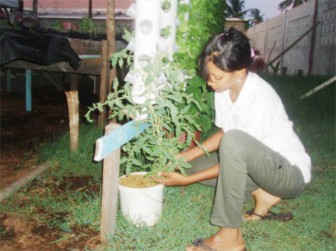
Sookraj is just one of the many success stories among the hundreds of people who have been trained in hydroponics by the Partners of the Americas (Guyana Chapter) in conjunction with the Inter-American Development Bank (IDB) and Canadian African Self Reliance International.
Over the last three years over three hundred people, some who farm to sell and others for the purposes of home use, were trained in hydroponic farming, and with a new four-year grant given to Partners of Americas by IDB and the Japanese Trust Funds and the Community Development Programme of the Japan Special Fund Poverty Reduction, more persons are expected to be trained.
President of Partners of Americas (Guyana Chapter) Myrtle Richards, recently back from El Salvador where she received the US$1.1M grant and an award on behalf of the partnership, hopes that another 800 people will be trained in the next four years.
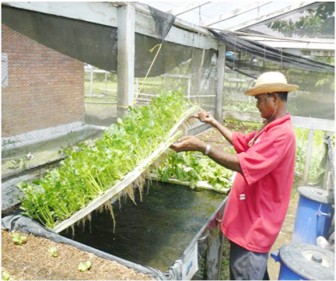
In an interview with the Sunday Stabroek Richards revealed that the idea to train persons in hydroponic farming was born out of the Great Flood in 2004-05 which affected many farmers on the coast. A volunteer who was with the partnership at the time noted that in Latin America hydroponic farming is done, and he sold the idea to them.
Initially farmers did not welcome the idea and Richards observed that change is not always something to which people are open; however, the second flood persuaded some to buy into the concept.
The idea was sold by the partnership building exhibition parks and it was there many persons realized if they do hydroponic farming they would not have to bend and plant since it is almost four feet off the ground and would be less strenuous.
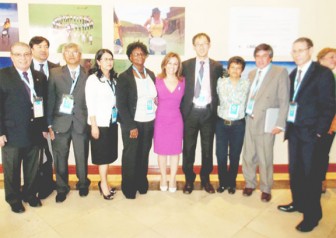
For this type of farming persons can use water, pure manure or a substrate with the latter containing different mixtures including two buckets of paddy shells, which have to be washed with soapy water and mixed with one bucket of sand. The paddy can be interchanged with coconut husk or some other mixture that might be popular in a given area but which must be recommended by the trainers. The dominant form used by farmers is the paddy shells and sand and Richards said the plants are most times in the bottom halves of bottles which are placed in pallets. Those pallets are lined with construction paper and barred up at the sides; they are then covered with plastic that has a net underneath.
At three feet intervals holes must be bored into the pallet and hoses are then inserted.
“What we do then is use a plant food – three mixtures; I don’t know the names, I know them as solution A, solution B and solution C, and you throw that on the plants in the mornings, and in the afternoons you water them with rainwater,” Richards explained.
Should the farmer be unable to get rainwater, Richards said, the farmer must then use fine sand as a filter when using other water, that is placed in a strainer through which the water would be poured.
Every week
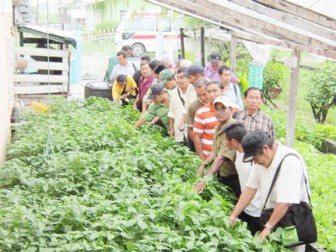
Richards said quickly the farmers realized that vegetables such as lettuce and pakchoy can be reaped every three or four weeks, and they encourage them to plant in such a way that every week they can reap a new set.
“When they realized it was working, it quickly caught on and when we realized it was catching on so fast that forced us to apply to the IDB multi-nation investment funding for a first grant,” Richards said, revealing that they were successful. The grant was for three years which came to an end last July.
During that grant the partnership worked in Regions 2, 3 4, 5 and 6, but she said when persons from other regions learnt about the project they called and asked for training, and as a result limited work was done in Region 10.
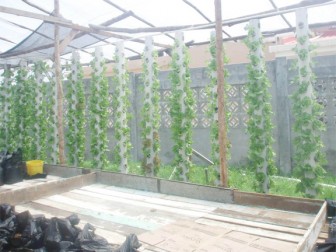
The partnership held workshops in various areas and she said the farmers would first start out on a trial and error basis because each area can be different, and what may work in one would not work in another.
And feedback from the farmers was very important to the success of the project even though Richards said initially many of the farmers had to be taught how to keep records.
“What we found farmers in Guyana they don’t keep records… so we had to teach them book-keeping and as long as they had computers and they had some kids who were computer literate we showed them how to do it on the computer, and so after that what you got was the exact figures,” Richards said.
When the project commenced they aimed to train 200 persons in the home-based farming skills over the three years, but in the end they trained some 360 persons, Richards revealed proudly. They were expected to make 30 exhibition shade houses during the three years, and in the end 49 were made.
They also arranged market for the produce and during the next four years, she said, they are hoping to open an export market for the farmers.
This type of farming proved to be very profitable for the farmers and as such it expanded rapidly, but it was the IDB which suggested and encouraged them to apply for the second grant. Out of over 1700 applicants the partnership was one of only seven organisations which received funding.
“You see they realized not only at IDB but in the world that food security is a big thing and the only one who had such a project…was us,” was how Richards explained their success.
She said a small shade house was also done at the IDB local office and many of its staff caught onto the technology and are now doing hydroponic farming at home.
New grant
With this new grant work will continue in the previous regions with Regions 9 and 10 being new additions, and over the four years it hoped that an additional 800 persons would be trained and it would be different from the previous training. She said the training would not be restricted to sand and paddy shells but also include coconut husks, and they would also be trained how to make compost. There is also a fourth technology consisting of humus which is made with pure manure, while red worms are imported from California, USA. These are put into the manure and they are eaten and then excreted by the earthworms, which makes the humus very fertile.
According to Richards, the taste of the plant also improves with this method, and she said in some areas this would now be used. The worms are imported by the partnership and a bag of them can be purchased for $1500 from the St Stanislaus farm. She said during the training session the worms would be free and would be given to the farmers for them to plant their first crop, but she advised they would have to keep making new humus because after a time the red worms intermingle with the local worms and they are not as effective.
“So when you realise it is not being that effective you have to get rid of it and buy new worms,” she said.
Asked how someone can be part of the training, Richards said anyone interested can be trained, and in addition to the training done in the various regions continuous training is done at the St Stanislaus College farm in North Sophia. It lasts for one day, and is offered on Mondays, Wednesdays and Fridays. After the training farmers sometimes immediately leave with their plants – given free – or at other times they are told to return in two days. The training is done by expert Mahadeo Panday from the farm.
Those who are interested in venturing into large-scale farming have to purchase the special plastic, which has a net on the inside. Those who cannot afford to purchase the plastic receive it free of cost.
Richards explained that in the last project they had a trained technical officer in each region who worked along with the farmers, and she also revealed that they trained all the Toshoas who attended the last conference held in Georgetown.
In addition to this project Partners of America (Guyana Chapter) is also involved in farmer-to-farmer projects which entail bringing in experts from overseas who will come into Guyana and work with farmers in various areas and teach new techniques.
Partners of the Americas was started in Washington DC in the mid 1960s by then President John F Kennedy. It is an organisation where ideas and volunteers are shared and a chapter has been set up in all US states; those chapters are mandated to network with a country. Guyana was networked with the state of Mississippi chapter, but for the last three or four years the president of that chapter moved to another state and the network has been more dormant than active.
The Guyana chapter was started in 1989 and the president said in the past few years the partnership has been doing a lot of work with Washington in the area of agriculture.




